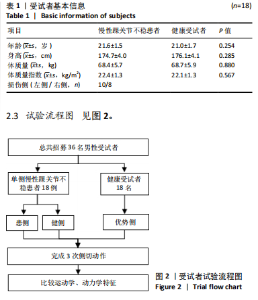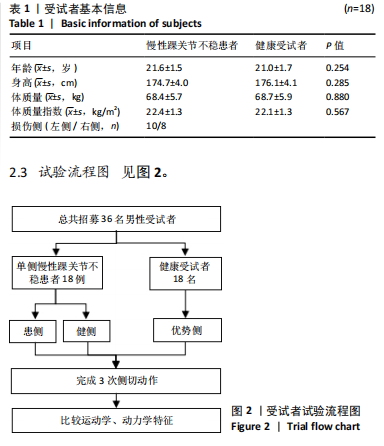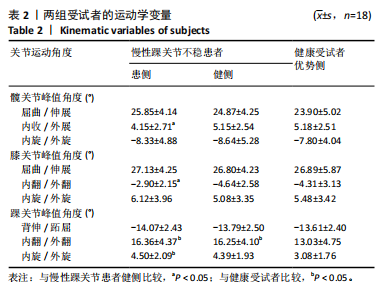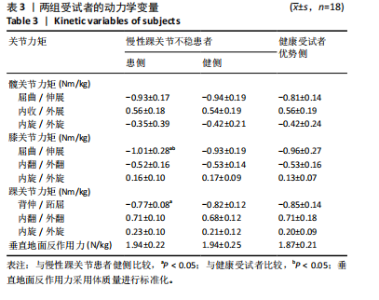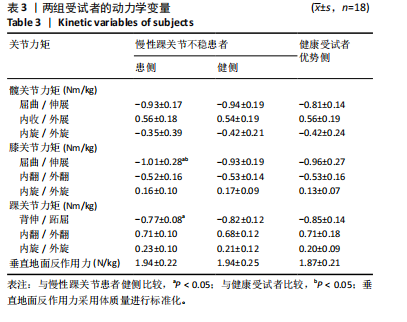Chinese Journal of Tissue Engineering Research ›› 2025, Vol. 29 ›› Issue (32): 6920-6926.doi: 10.12307/2025.974
Previous Articles Next Articles
Bilateral lower limb biomechanical abnormalities in patients with unilateral chronic ankle instability
Guo Ping1, Wang Juan2
- 1College of Physical Education, Hanjiang Normal University, Shiyan 442000, Hubei Province, China; 2School of Sports Medicine, Wuhan Sports University, Wuhan 430079, Hubei Province, China
-
Received:2024-11-06Accepted:2024-12-25Online:2025-11-18Published:2025-04-26 -
Contact:Wang Juan, Master, Intermediate experimentalist, School of Sports Medicine, Wuhan Sports University, Wuhan 430079, Hubei Province, China -
About author:Guo Ping, Master, Lecturer, College of Physical Education, Hanjiang Normal University, Shiyan 442000, Hubei Province, China -
Supported by:Teaching and Research Project of Hubei Province Department of Education, No. 2021407 (to WJ)
CLC Number:
Cite this article
Guo Ping, Wang Juan. Bilateral lower limb biomechanical abnormalities in patients with unilateral chronic ankle instability[J]. Chinese Journal of Tissue Engineering Research, 2025, 29(32): 6920-6926.
share this article
Add to citation manager EndNote|Reference Manager|ProCite|BibTeX|RefWorks
| [1] ROOS KG, KERR ZY, MAUNTEL TC, et al. The Epidemiology of Lateral Ligament Complex Ankle Sprains in National Collegiate Athletic Association Sports. Am J Sports Med. 2017;45(1):201-209. [2] KUDO S, AOYAGI T, KOBAYASHI T, et al. Ultrasound Imaging of Subtalar Joint Instability for Chronic Ankle Instability. Healthcare (Basel). 2023; 11(15):2227. [3] WIKSTROM EA, BROWN CN. Minimum reporting standards for copers in chronic ankle instability research. Sports Med. 2014;44(2):251-268. [4] DOHERTY C, BLEAKLEY C, HERTEL J, et al. Recovery From a First-Time Lateral Ankle Sprain and the Predictors of Chronic Ankle Instability: A Prospective Cohort Analysis. Am J Sports Med. 2016;44(4):995-1003. [5] HERTEL J, CORBETT RO. An Updated Model of Chronic Ankle Instability. J Athl Train. 2019;54(6):572-588. [6] SIMPSON JD, STEWART EM, RENDOS NK, et al. Anticipating ankle inversion perturbations during a single-leg drop landing alters ankle joint and impact kinetics. Hum Mov Sci. 2019;66:22-30. [7] DOHERTY C, BLEAKLEY C, HERTEL J, et al. Single-leg drop landing movement strategies in participants with chronic ankle instability compared with lateral ankle sprain ‘copers’. Knee Surg Sports Traumatol Arthrosc. 2016;24(4):1049-1059. [8] KIM H, SON SJ, SEELEY MK, et al. Altered Movement Biomechanics in Chronic Ankle Instability, Coper, and Control Groups: Energy Absorption and Distribution Implications. J Athl Train. 2019;54(6):708-717. [9] SIMPSON JD, KOLDENHOVEN RM, WILSON SJ, et al. Ankle kinematics, center of pressure progression, and lower extremity muscle activity during a side-cutting task in participants with and without chronic ankle instability. J Electromyogr Kinesiol. 2020;54:102454. [10] SIMPSON JD, STEWART EM, MACIAS DM, et al. Individuals with chronic ankle instability exhibit dynamic postural stability deficits and altered unilateral landing biomechanics: A systematic review. Phys Ther Sport. 2019;37:210-219. [11] KIM H, SON SJ, SEELEY MK, et al. Kinetic Compensations due to Chronic Ankle Instability during Landing and Jumping. Med Sci Sports Exerc. 2018;50(2):308-317. [12] PETERKA RJ. Sensory integration for human balance control. Handb Clin Neurol. 2018;159:27-42.
[13] HU X, FENG T, LI P, et al. Bilateral Sensorimotor Impairments in Individuals with Unilateral Chronic Ankle Instability: A Systematic Review and Meta-Analysis. Sports Med Open. 2024;10(1):33. [14] KHALAJ N, VICENZINO B, HEALES LJ, et al. Is chronic ankle instability associated with impaired muscle strength? Ankle, knee and hip muscle strength in individuals with chronic ankle instability: a systematic review with meta-analysis. Br J Sports Med. 2020;54(14):839-847. [15] SONG K, JANG J, NOLTE T, et al. Dynamic reach deficits in those with chronic ankle instability: A systematic review and meta-analysis. Phys Ther Sport. 2022;53:40-50. [16] SOUSA A SP, SILVA M, GONZALEZ S, et al. Bilateral compensatory postural adjustments to a unilateral perturbation in subjects with chronic ankle instability. Clin Biomech (Bristol). 2018;57:99-106. [17] SIMPSON JD, RENDOS NK, STEWART EM, et al. Bilateral spatiotemporal postural control impairments are present in participants with chronic ankle instability. Phys Ther Sport. 2019;39:1-7. [18] WARD S, PEARCE AJ, PIETROSIMONE B, et al. Neuromuscular deficits after peripheral joint injury: a neurophysiological hypothesis. Muscle Nerve. 2015;51(3):327-332. [19] SOUSA A SP, LEITE J, COSTA B, et al. Bilateral Proprioceptive Evaluation in Individuals With Unilateral Chronic Ankle Instability. J Athl Train. 2017;52(4):360-367. [20] SUTTMILLER AMB, MCCANN RS. Neural excitability of lower extremity musculature in individuals with and without chronic ankle instability: A systematic review and meta-analysis. J Electromyogr Kinesiol. 2020;53: 102436. [21] HILLER CE, REFSHAUGE KM, BUNDY AC, et al. The Cumberland ankle instability tool: a report of validity and reliability testing. Arch Phys Med Rehabil. 2006;87(9):1235-1241. [22] CHEN P, WANG L, DONG S, et al. Can Symmetry of Single-Leg Vertical Jump Height Represent Normal Lower Limb Biomechanics of Athletes After Anterior Cruciate Ligament Reconstruction? Sports Health. 2024; 16(4):596-605. [23] 陈鹏, 左会武, 王玲, 等. 前交叉韧带重建术后运动员单腿垂直跳跃高度对称性掩盖其异常下肢生物力学[J]. 中国运动医学杂志, 2023,42(12): 939-947. [24] WANG L, CHEN P, DING Y, et al. Effects of Kinesio taping on lower limb biomechanical characteristics during unexpected jumping in patients with chronic ankle instability. Scand J Med Sci Sports. 2024;34(1): e14566. [25] ZHANG S, WANG L, LIU X, et al. Effects of Kinesio taping on lower limb biomechanical characteristics during the cutting maneuver in athletes after anterior cruciate ligament reconstruction. PLoS One. 2024;19(3): e0299216. [26] LEE H, HAN S, HOPKINS JT. Balance Training With Stroboscopic Glasses and Neuromechanics in Patients With Chronic Ankle Instability During a Single-Legged Drop Landing. J Athl Train. 2024;59(6):633-640. [27] LEPLEY LK, WOJTYS EM, PALMIERI-SMITH RM. Combination of eccentric exercise and neuromuscular electrical stimulation to improve biomechanical limb symmetry after anterior cruciate ligament reconstruction. Clin Biomech (Bristol). 2015;30(7):738-747. [28] PANAGIOTAKIS E, MOK KM, FONG DT, et al. Biomechanical analysis of ankle ligamentous sprain injury cases from televised basketball games: Understanding when, how and why ligament failure occurs. J Sci Med Sport. 2017;20(12):1057-1061. [29] GEHRING D, WISSLER S, LOHRER H, et al. Expecting ankle tilts and wearing an ankle brace influence joint control in an imitated ankle sprain mechanism during walking. Gait Posture. 2014;39(3):894-898. [30] LI Y, KO J, ZHANG S, et al. Biomechanics of ankle giving way: A case report of accidental ankle giving way during the drop landing test. J Sport Health Sci. 2019;8(5):494-502. [31] REMUS A, CAULFIELD B, DOHERTY C, et al. A laboratory captured “giving way” episode in an individual with chronic ankle instability. J Biomech. 2018;76:241-246. [32] ZHANG Z, ZHANG M. Effect of different ankle braces on lower extremity kinematics and kinetics following special-induced fatigue for volleyball players with functional ankle instability. Heliyon. 2023;9(6):e16380. [33] SIMPSON JD, STEWART EM, MOSBY AM, et al. Lower-Extremity Kinematics During Ankle Inversion Perturbations: A Novel Experimental Protocol That Simulates an Unexpected Lateral Ankle Sprain Mechanism. J Sport Rehabil. 2019;28(6):593-600. [34] SIMPSON JD, STEWART EM, TURNER AJ, et al. Neuromuscular control in individuals with chronic ankle instability: A comparison of unexpected and expected ankle inversion perturbations during a single leg drop-landing. Hum Mov Sci. 2019;64:133-141. [35] HERB CC, GROSSMAN K, FEGER MA, et al. Lower Extremity Biomechanics During a Drop-Vertical Jump in Participants With or Without Chronic Ankle Instability. J Athl Train. 2018;53(4):364-371. [36] KIKUMOTO T, SUZUKI S, TAKABAYASHI T, et al. Center of Pressure Deviation during Posture Transition in Athletes with Chronic Ankle Instability. Int J Environ Res Public Health. 2023;20(8):5506. [37] ALKASLASI MR, PICCUS ZE, HAREENDRAN S, et al. Single nucleus RNA-sequencing defines unexpected diversity of cholinergic neuron types in the adult mouse spinal cord. Nat Commun. 2021;12(1):2471. [38] HILLER CE, NIGHTINGALE EJ, LIN CW, et al. Characteristics of people with recurrent ankle sprains: a systematic review with meta-analysis. Br J Sports Med. 2011;45(8):660-672. [39] SON SJ, KIM H, SEELEY MK, et al. Movement Strategies among Groups of Chronic Ankle Instability, Coper, and Control. Med Sci Sports Exerc. 2017;49(8):1649-1661. [40] KIM H, SON SJ, SEELEY MK, et al. Altered movement strategies during jump landing/cutting in patients with chronic ankle instability. Scand J Med Sci Sports. 2019;29(8):1130-1140. [41] CUYUL-VáSQUEZ I, ÁLVAREZ E, RIQUELME A, et al. Effectiveness of Unilateral Training of the Uninjured Limb on Muscle Strength and Knee Function of Patients With Anterior Cruciate Ligament Reconstruction: A Systematic Review and Meta-Analysis of Cross-Education. J Sport Rehabil. 2022;31(5):605-616. [42] HALE SA, FERGUS A, AXMACHER R, et al. Bilateral improvements in lower extremity function after unilateral balance training in individuals with chronic ankle instability. J Athl Train. 2014;49(2):181-191. [43] CIRER-SASTRE R, BELTRáN-GARRIDO JV, CORBI F. Contralateral Effects After Unilateral Strength Training: A Meta-Analysis Comparing Training Loads. J Sports Sci Med. 2017;16(2):180-186. [44] RUDDY KL, LEEMANS A, WOOLLEY DG, et al. Structural and Functional Cortical Connectivity Mediating Cross Education of Motor Function. J Neurosci. 2017;37(10):2555-2564. [45] ABBOTT EM, STEPHENS JD, SIMHA SN, et al. Attenuation of muscle spindle firing with artificially increased series compliance during stretch of relaxed muscle. Exp Physiol. 2024;109(1):148-158. [46] WU X, SONG W, ZHENG C, et al. Morphological study of mechanoreceptors in collateral ligaments of the ankle joint. J Orthop Surg Res. 2015;10:92. [47] ZHANG R, ZHANG X, CHEN Y, et al. Current perception threshold testing in chronic ankle instability. BMC Musculoskelet Disord. 2021;22(1): 453. |
| [1] | Li Liangkui, Huang Yongcan, Wang Peng, Yu Binsheng. Effect of anterior controllable anteriodisplacement and fusion on vertebrae-ossification of posterior longitudinal ligament complex and implants: a finite element analysis [J]. Chinese Journal of Tissue Engineering Research, 2025, 29(9): 1761-1767. |
| [2] | Xu Biao, Lu Tan, Jiang Yaqiong, Yin Yujiao. Xu Biao, Lu Tan, Jiang Yaqiong, Yin Yujiao [J]. Chinese Journal of Tissue Engineering Research, 2025, 29(9): 1768-1774. |
| [3] | Zhou Jinhai, Li Jiangwei, Wang Xuquan, Zhuang Ying, Zhao Ying, Yang Yuyong, Wang Jiajia, Yang Yang, Zhou Shilian. Three-dimensional finite element analysis of anterior femoral notching during total knee arthroplasty at different bone strengths [J]. Chinese Journal of Tissue Engineering Research, 2025, 29(9): 1775-1782. |
| [4] | Fu Enhong, Yang Hang, Liang Cheng, Zhang Xiaogang, Zhang Yali, Jin Zhongmin. OpenSim-based prediction of lower-limb biomechanical behavior in adolescents with plantarflexor weakness [J]. Chinese Journal of Tissue Engineering Research, 2025, 29(9): 1789-1795. |
| [5] | Sun Xiaojun, Wang Huaming, Zhang Dehong, Song Xuewen, Huang Jin, Zhang Chen, Pei Shengtai. Effect of finite element method in treatment of developmental dysplasia of the hip in children [J]. Chinese Journal of Tissue Engineering Research, 2025, 29(9): 1897-1904. |
| [6] | Lu Jieming, Li Yajing, Du Peijie, Xu Dongqing. Effects of artificial turf versus natural grass on biomechanical performance of the lower limbs in young females during jump-landing [J]. Chinese Journal of Tissue Engineering Research, 2025, 29(6): 1101-1107. |
| [7] | Wu Yihan, Liu Zhongqiang, Wei Qiaoye, Liu Mingdong, Chen Keyi, Li Zhigang. Effect of balance training with different visual conditions on proprioception in patients with chronic ankle instability [J]. Chinese Journal of Tissue Engineering Research, 2025, 29(5): 1050-1057. |
| [8] | Song Xubin, Wu Dou, Zhao Enzhe, Zhang Xingyu, Zhang Xiaolun, Wang Chuheng. Finite element analysis of a new femoral neck spiral blade system to treat femoral intertrochanteric fractures [J]. Chinese Journal of Tissue Engineering Research, 2025, 29(33): 7041-7047. |
| [9] | Wang Lei, Li Chengsong, Zhang Shenshen, Wang Qing. Finite element analysis of biomechanical characteristics of three internal fixation methods in treatment of inferior patellar fracture [J]. Chinese Journal of Tissue Engineering Research, 2025, 29(33): 7048-7054. |
| [10] | Xu Xin, Wurikaixi·Aiyiti, Lyu Gang, Maimaiaili·Yushan, Ma Zhiqiang, Ma Chao. Finite element analysis of four different internal fixation methods for complex acetabular double-column fractures [J]. Chinese Journal of Tissue Engineering Research, 2025, 29(33): 7063-7071. |
| [11] | Liang Cheng, Zhuo Chuanchuan, Zhang Xiaogang, Wang Guan, Duan Ke, Li Zhong, Lu Xiaobo, Zhuo Naiqiang, Jin Zhongmin. Biomechanical characteristics of a novel sacroiliac lag screw [J]. Chinese Journal of Tissue Engineering Research, 2025, 29(33): 7080-7086. |
| [12] | Ma Shuangshuang, Gao Dedong, Shan Zhongshu, Xu Wenxu, Lu Zhirui. Finite element analysis and biomechanical validation of revision pedicle screw placement [J]. Chinese Journal of Tissue Engineering Research, 2025, 29(33): 7087-7095. |
| [13] | Yang Yu, Li Yinghao, Duo Zhuangzhi, Zhou Dingrong. Effect of overall functional physical exercise on lumbar biomechanics in patients with lumbar disc herniation after surgery [J]. Chinese Journal of Tissue Engineering Research, 2025, 29(33): 7096-7101. |
| [14] | Zhang Ziyi, Qin Qi, Alimujiang·Yusufu, Liu Yuzhe, Yusufu·Reheman, Ran Jian. Biomechanical analysis of three internal fixation schemes for Pauwels type III femoral neck fractures in young adults [J]. Chinese Journal of Tissue Engineering Research, 2025, 29(33): 7102-7108. |
| [15] | Liu Mengling, Li Yongjie, Liu Hongju. Effect of increased stride length on knee kinematics and dynamics of asymmetric gait after anterior cruciate ligament reconstruction [J]. Chinese Journal of Tissue Engineering Research, 2025, 29(33): 7109-7115. |
| Viewed | ||||||
|
Full text |
|
|||||
|
Abstract |
|
|||||
